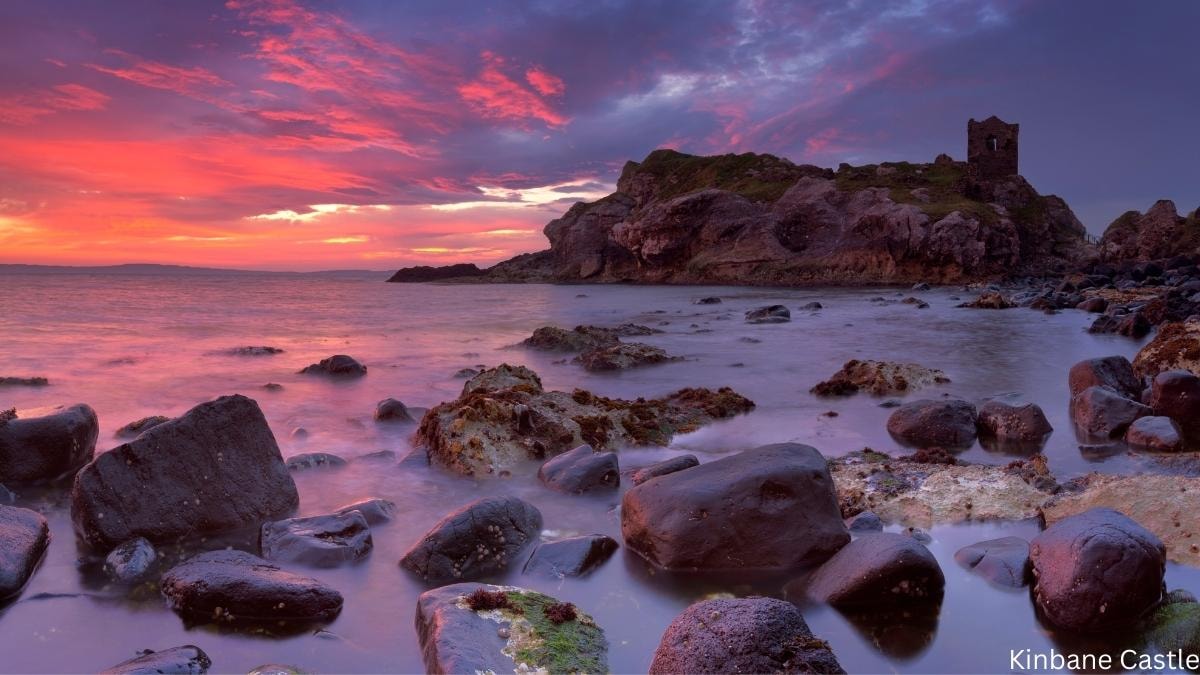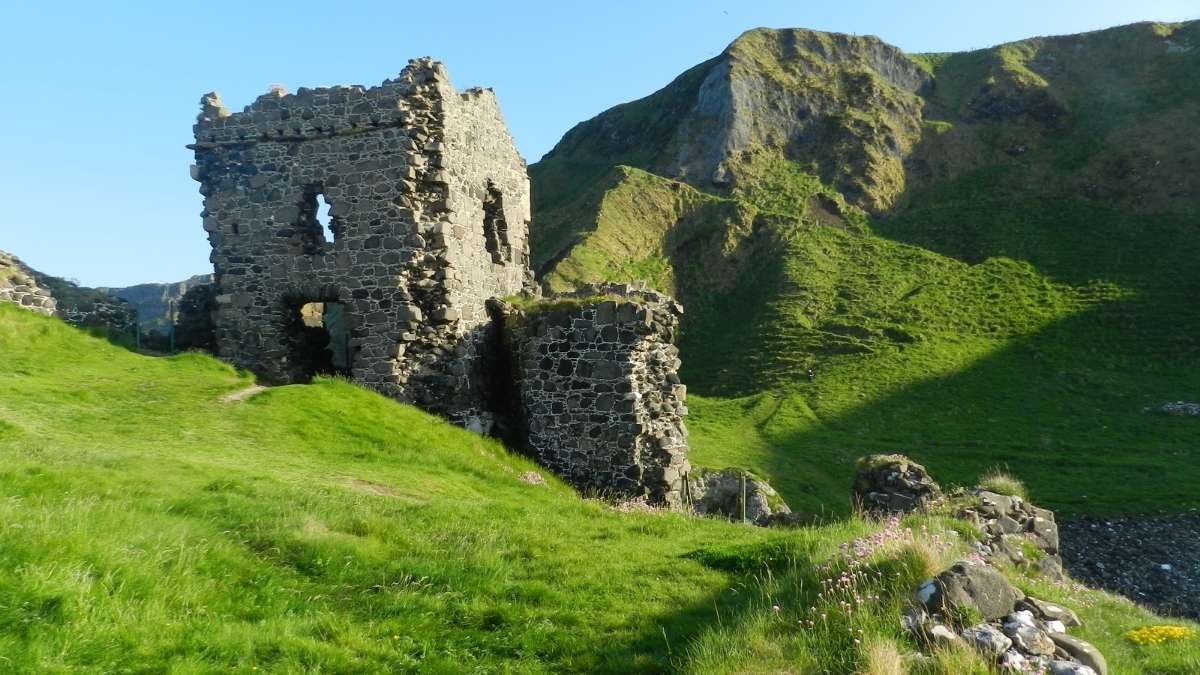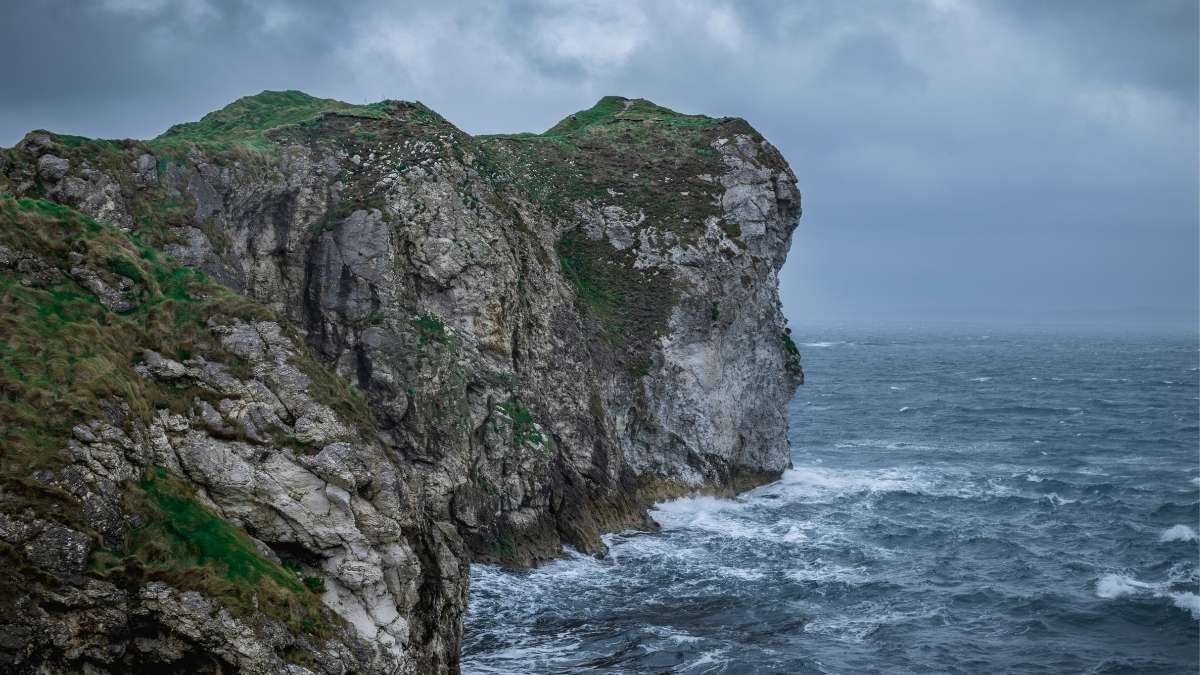Perched atop a dramatic cliff on Northern Ireland's rugged Antrim coast, Kinbane Castle captures the imagination of visitors with its striking location and rich history.
Built in 1547 by Colla MacDonnell, this small two-story castle once served as a strategic stronghold for the MacDonnell clan.

Today, the ruins of Kinbane Castle offer a glimpse into 16th-century Irish history and stunning views of the surrounding coastline.
The limestone headland on which it sits juts out into the sea, creating a natural defensive position that made the castle difficult to attack.
Visitors can explore the castle remains and learn about its tumultuous past, including sieges by English forces in the 1550s.
The site's breathtaking scenery, with crashing waves and rugged cliffs, makes it a photographer's dream and a popular spot for hikers exploring the Causeway Coastal Route.
History of Kinbane Castle

Kinbane Castle was built in 1547 by Colla MacDonnell, brother of Sorley Boy MacDonnell.
The castle sits on a small rocky promontory called Kinbane Head, jutting out into the sea on the north coast of County Antrim, Northern Ireland. Kinbane means white head, a name derived from the Irish "An Cionn Bán," referring to the white limestone on which the castle stands. Its strategic location allowed the MacDonnells to control the surrounding waters and coastline.
In 1551, the castle was attacked and partially destroyed by English forces under Lord Deputy Sir James Croft, with english soldiers laying siege to the stronghold. The MacDonnells quickly rebuilt it, demonstrating the castle's importance to their territory. Colla MacDonnell died defending the castle during this turbulent period, solidifying its place in the clan's storied resistance.
Kinbane Castle played a significant role in the MacDonnell clan's resistance against English rule in the area. It served as a stronghold during various conflicts throughout the 16th century.
By the early 17th century, the castle had fallen into disuse. The harsh coastal environment and centuries of weathering have left only ruins standing today. The ruins, now a scheduled historic monument and a state care historic monument, offer visitors a glimpse into the castle's turbulent past and strategic significance.
These remnants provide spectacular views of the dramatic coastal scenery that surrounds this ancient fortress, making it a must-visit site for those exploring Northern Ireland.
Geographical Setting of Kinbane Castle

Kinbane Castle sits on a narrow limestone headland projecting into the sea on the north coast of County Antrim, Northern Ireland. The dramatic location offers stunning views of Rathlin Island and the Mull of Kintyre in Scotland.
The castle ruins perch precariously on a small rock promontory, surrounded by steep cliffs that plunge into the churning waters of the North Channel below. This natural defensive position made it an ideal spot for a stronghold.
Access to Kinbane Castle is via a steep path down the cliffside. The isolated setting contributed to its strategic importance but also its vulnerability to attack from the sea.
The area around Kinbane features rugged coastal scenery typical of the Antrim coast. Basalt cliffs, formed by ancient lava flows, dominate the landscape. These dramatic rock formations create a striking backdrop for the castle ruins.
Kinbane Head lies approximately 5 kilometers east of Ballycastle and 3 kilometers west of Ballintoy. Its remote location along the Causeway Coastal Route attracts visitors seeking to explore Northern Ireland's scenic coastline and historic sites.
Architectural Features of Kinbane Castle
Key architectural Features of Kinbane Castle include:
-
Vaulted ground floor
-
Stone spiral staircase
-
Battlements atop the tower
-
Machicolations for defense
Kinbane Castle's most prominent feature is its two-story rectangular tower house. Built in the 16th century, the structure stands on a narrow limestone promontory jutting into the sea.
The castle's walls are constructed of local stone, providing sturdy defense against both natural elements and potential attackers. Narrow windows pierce these thick walls, allowing for light and ventilation while maintaining security.
A small courtyard surrounds the tower house, enclosed by protective walls. This area likely housed additional wooden structures for daily castle operations.
Access to Kinbane Castle was limited by its strategic position. A narrow path along the clifftop served as the only land route to the fortress, enhancing its defensibility.
The castle's design prioritized functionality over ornamentation, reflecting its primary purpose as a defensive stronghold. Its compact layout and robust construction allowed it to withstand centuries of harsh coastal conditions.
Kinbane Castle in Cultural Media
Kinbane Castle has featured in various forms of media, capturing the imagination of artists and audiences alike. The castle's dramatic clifftop setting has made it a popular location for photographers and filmmakers.
Several Irish tourism campaigns have showcased Kinbane Castle, highlighting its rugged beauty and historical significance. These promotions have helped raise awareness of the site among potential visitors.
In literature, Kinbane Castle has appeared in historical novels and travel guides focused on Northern Ireland. Authors often emphasize its romantic atmosphere and turbulent past.
The castle has also been featured in documentaries about Irish history and architecture. These programs typically explore Kinbane's strategic importance and its role in clan conflicts.
Local artists have depicted Kinbane Castle in paintings and sculptures, often emphasizing its integration with the surrounding landscape. These works can be found in galleries and exhibitions throughout Northern Ireland.
Some video games set in medieval Ireland have included representations of Kinbane Castle. While not always historically accurate, these digital recreations help introduce the site to younger audiences.
Social media platforms have contributed to Kinbane Castle's visibility. Visitors frequently share photos and videos of the castle, spreading its image to a global audience.
Conservation Efforts for Kinbane Castle
Kinbane Castle has undergone significant preservation work to protect its remaining structures. The Northern Ireland Environment Agency oversees the site's conservation, implementing measures to stabilize the ruins and prevent further deterioration.
In 2012, emergency repairs were carried out to address erosion issues threatening the castle's foundations. This involved reinforcing the cliff face and installing drainage systems to divert water away from vulnerable areas.
Ongoing maintenance includes:
-
Regular inspections
-
Vegetation removal
-
Repointing of stonework
-
Installation of protective barriers
Public access to Kinbane Castle, partly destroyed but still retaining its historical charm, has been carefully managed to balance visitor experience with site preservation. Designated viewing areas and pathways in the area surrounding Kinbane Castle help minimize impact on its fragile structures.
The conservation team employs advanced surveying techniques, including 3D scanning, to monitor the castle's condition. This data informs future preservation strategies, particularly for plans to rebuilt Kinbane Castle at a later date Kinbane Castle, and aids in creating detailed records of the site.
Educational initiatives have been implemented to raise awareness about the castle's historical significance and conservation needs. Interpretive panels and guided tours provide visitors with information on the causeway coast as well as preservation efforts and the importance of protecting cultural heritage sites, including insights into the date Kinbane Castle was originally constructed.
Funding for conservation work comes from government allocations and private donations. A "Friends of Kinbane Castle" group has been established to support ongoing preservation efforts through fundraising and volunteer activities.
Public Access and Amenities
Kinbane Castle is open to visitors year-round. The site offers free admission and parking for those wishing to explore the ruins and surrounding landscape.
A small car park is available at the top of the cliff. From there, visitors must descend a steep staircase to reach the castle remains.
The path to the castle can be challenging for some. It involves uneven terrain and over 140 steps. Sturdy footwear is recommended, especially in wet conditions.
Basic informational signs are posted around the site. These provide historical context and details about the castle's features.
There are no modern facilities at Kinbake Castle itself. The nearest public restrooms and refreshments can be found in nearby Ballycastle, about 5 miles away.
Photography is permitted throughout the site. The dramatic coastal setting offers numerous picturesque views for visitors to capture.
Guided tours are not available, but visitors are free to explore the castle ruins at their own pace. The site typically takes 30-60 minutes to fully experience.
For safety reasons, access may be restricted during extreme weather conditions. Visitors should check local forecasts before planning their trip.
Wildlife and Natural Surroundings Near Kinbane Castle
Kinbane Castle's coastal location provides a habitat for diverse wildlife. Seabirds nest along the cliffs, including fulmars, kittiwakes, and razorbills. Visitors may spot grey seals swimming offshore or basking on nearby rocks.
The surrounding area features rugged grasslands and coastal heaths. These ecosystems support various plant species adapted to the harsh coastal environment. Wild flowers like sea thrift and bird's-foot trefoil add splashes of color during spring and summer.
Small mammals inhabit the area, including rabbits and field mice. Birdwatchers can observe coastal and inland species such as oystercatchers, rock pipits, and meadow pipits. The castle's stone walls provide nesting sites for swallows and house martins.
Marine life thrives in the waters below Kinbane Head. Rockpools near the base of the cliffs contain crabs, anemones, and small fish. The nutrient-rich waters attract larger sea creatures, including dolphins and porpoises occasionally seen from the headland.
The dramatic landscape surrounding Kinbane Castle offers breathtaking views. Visitors can enjoy panoramic vistas of the North Channel, Rathlin Island, and the Scottish coast on clear days. The interplay of sea, sky, and rugged terrain creates a constantly changing natural spectacle.
Frequently Asked Questions On Kinbane Castle
1. Who lived in Kinbane Castle?
Colla MacDonnell, a Scottish clan chief, built and inhabited Kinbane Castle in the 16th century. The MacDonnell clan controlled the castle for several generations.
2. What is the history of Kinbane Castle?
Kinbane Castle was constructed in 1547 by Colla MacDonnell. It served as a strategic stronghold along the Antrim coast.
The castle endured attacks from English forces in 1551 and 1555. Despite partial destruction, the MacDonnells rebuilt and maintained control of the fortress.
3. How many steps are there to reach Kinbane Castle?
Visitors must descend approximately 140 steps to reach Kinbane Castle.
The steep staircase leads from the clifftop car park to the headland where the castle ruins stand. The climb back up can be challenging for some visitors.
4. Has Kinbane Castle been featured in any television or film productions?
Kinbane Castle has not been prominently featured in major television shows or films.
Its remote location and small size make it less suitable for large-scale productions. Local documentaries and travel shows have occasionally showcased the castle's dramatic setting.
5. Are there any restoration projects for Kinbane Castle?
Currently, there are no major restoration projects underway at Kinbane Castle.
The site is managed by the Northern Ireland Environment Agency. Conservation efforts focus on preserving the existing ruins and ensuring visitor safety on the headland.
6. How can one obtain tickets to visit Kinbane Castle?
No tickets are required to visit Kinbane Castle. The site is freely accessible to the public year-round.
Visitors can park at the designated car park and walk down to the ruins. It's advisable to check local weather conditions before planning a visit.
